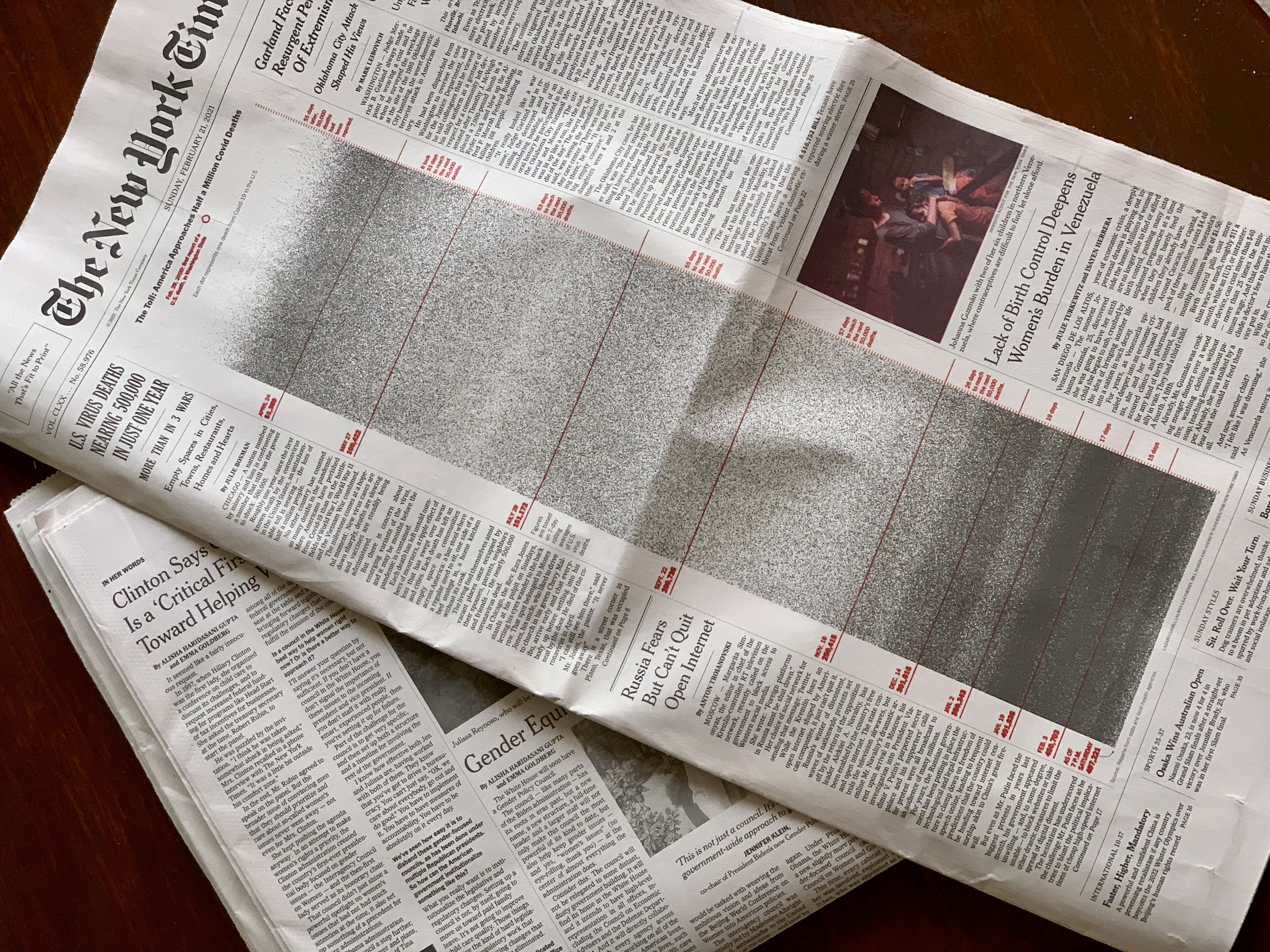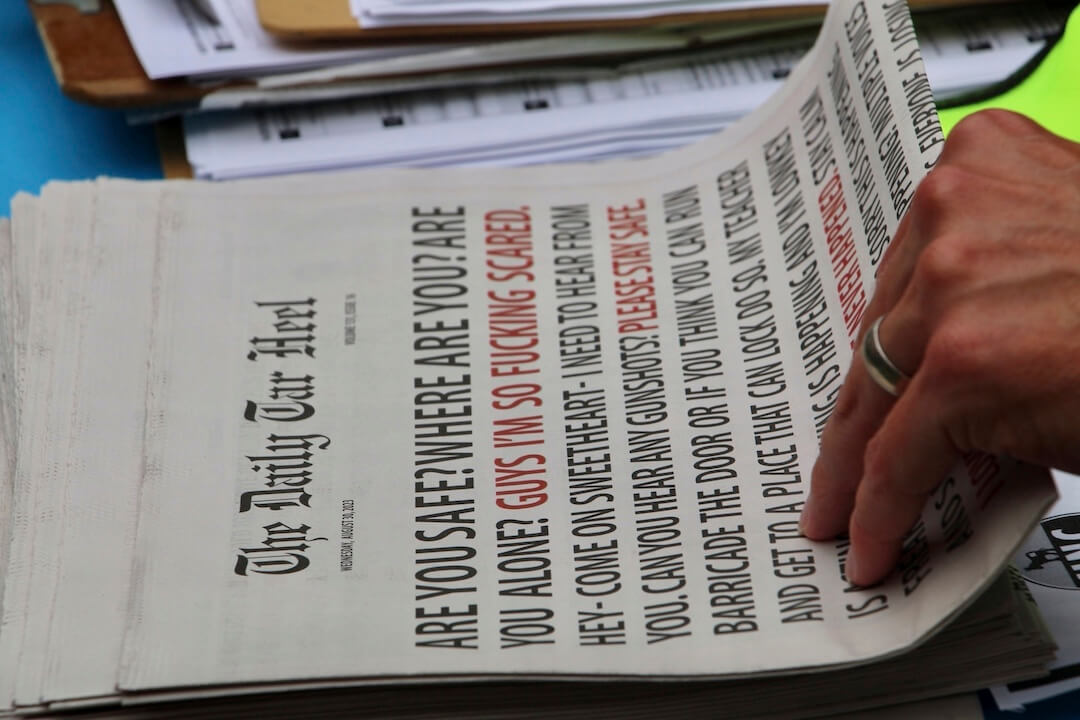Much attention has been paid to this unusual front page of the University of North Carolina Daily Tar Heel. It caught the attention of the president of the United States. A graduate student murdered his adviser, and the student body, starting a new semester, suddenly became prisoners in an existential lockdown of what Danish theologian Søren Kierkegaard called “fear and trembling.”
It matters not that the singular murder does not qualify as a mass shooting. The effects on the community were the same. I would argue that by now every American — and everyone who visits America — suffers from a form of post-traumatic stress related to gun violence. We have “witnessed” so many mass killings via news coverage that few could imagine any longer that this “could not happen here,” at our church, school, mall, or theater.
Long gone are the days when we heard a gunshot and thought it was a car backfiring. Now we hear the backfire and assume it is the sound of one human being trying to kill another.
Standard coverage of these shootings has become so routine and predictable that one event blends into another. Where we once could recite the names of places where mass killings had taken place — Columbine or Sandy Hook — now the names of places, murderers, victims, survivors lose their particularity, and congeal into a dark place in our collective consciousness.
We know what standard and responsible coverage looks like, simply by following four of the five W’s. We do need to know the who, what, where, and when. It’s at the why where we hit a wall. Remember the guy who took bags of weapons and ammunition into a hotel room high over the Las Vegas Strip? From there he shot like a sniper and killed 60 people and wounded many more attending an outdoor concert. Besides insanity and evil, what other reasons do we have for why he did it? None so far.
That kind of standard reporting fulfills the most common theory of news, a theory of “transmission,” that it’s the job of the journalist to transmit information to readers in the public interest, to tell them things they need to know, perhaps to help them take action or avoid a panic.
That is not what is happening on the front page of The Daily Tar Heel. Instead, a new team of editors and their young staff felt an instinct that would lead them in another direction. They would deliver more than reported information, which would have already been available to the public from more traditional sources. They opted instead for an expression of communal fear and suffering, a litany of text messages, that dragged us all into what it must have been like to hide in place, not knowing if this would be the last day of your life.
This was not the transmission of news. It was news as ritual.
News as a communal experience

The front page of the Sunday, Feb. 21, 2021 edition of The New York Times (Ren LaForme/Poynter)
In my book, “Tell It Like It Is: A Guide to Clear and Honest Writing,” I devote a chapter to the experience of news as ritual. The best example I found in recent years was on the front page of The New York Times.
I wrote that, in spite of social distances, the news of the pandemic had been defined by crowds. Emergency rooms stuffed to the point of triage. Humans cramming testing or vaccination sites. Small armies of protesters marching for social justice. Insurrectionists swarming the Capitol. The National Guard protecting the inauguration. Cars in Texas lined up for water.
Less visible by definition, but just as important, is not the emptiness of news, but the news of emptiness.
No expression of journalism will mark that tension between crowdedness and emptiness than the Feb. 21, 2021, Sunday front page of The New York Times, especially the dramatic graphic and the accompanying story by Julie Bosman.
The data graphic — by Lazaro Gamio, Lauren Leatherby, Bill Marsh and Andrew Sondern — is an exercise in informational and emotional pointillism. In 19th-century art, French painters would use tiny points of paint to create an impression of a scene or landscape. Here each point represents a death from COVID-19, one of almost 500,000.
The visual effect is that of a monolith, an eerie, morbid two-dimensional column of print. Following the time markers, the earlier months look grayer with some white space visible. As the pandemic roars toward the present, the points become more crowded in less time and the image becomes almost black — a shadow of death.
In typography, a block of impenetrable gray type is called a tombstone. This image is a tombstone for the lost, a twin tower before its collapse.
It is the language of loss that marks the diction (the total effect of words chosen) in the accompanying story by Bosman, assisted in reporting by four colleagues. In many ways, Bosman’s story is as remarkable and unusual as the graphic, news that transcends daily reportage.
She begins with a wise decision: to liberate the startling truths of the pandemic from the chains of decorative language, creating the illusion that the startling facts speak for themselves:
CHICAGO — A nation numbed by misery and loss is confronting a number that still has the power to shock: 500,000.
Roughly one year since the first known death by the coronavirus in the United States, an unfathomable toll is nearing — the loss of half a million people.
No other country has counted so many deaths in the pandemic. More Americans have perished from Covid-19 than on the battlefields of World War I, World War II and the Vietnam War combined.
The milestone comes at a hopeful moment: New virus cases are down sharply, deaths are slowing and vaccines are steadily being administered.
But there is concern about emerging variants of the virus, and it may be months before the pandemic is contained.
Numbers are often underappreciated as elements of news and narrative, but, like the number 6 million in signifying the Holocaust, 500,000 earns a place at the end of the first sentence, a position where no reader can ignore it. At the end of the next paragraph, the number is repeated but with humanity attached: “the loss of half a million people.”
She may not have intended it, but the repetition of the word “loss,” which also appears in the headline, is a real-life answer to questions we’ve asked for decades in writing workshops: “What is your story really about? Can you say it in one word?”
As you read Bosman’s story, notice how often the language of loss appears with creative and purposeful repetition and variation, a monolith of language. It gains momentum with her next two paragraphs
Each death has left untold numbers of mourners, a ripple effect of loss that has swept over towns and cities. Each death has left an empty space in communities across America: a bar stool where a regular used to sit, one side of a bed unslept in, a home kitchen without its cook.
The living find themselves amid vacant places once occupied by their spouses, parents, neighbors and friends — the nearly 500,000 coronavirus dead.
Listen to the language: loss, empty space, used to sit, unslept in, without, vacant places … it continues on and on deep into the story.
With the help of her colleagues, the writer flies virtually across the nation and descends to find the deeply human absence experienced by survivors of the lost, to give names to a few of the dead. By “landing” in cities across the landscape, she creates a sense of national and universal loss, one of the few times in the current moment when, whatever our divisions, we can feel the suffering of others.
Toward the end of the story, Bosman quotes a funeral director who finds himself using the same language to describe what he has experienced through the pandemic:
“People are feeling a psychological and spiritual void,” said Paddy Lynch, a funeral director in Michigan who has worked with families who have lost relatives to the coronavirus.
Part of that void, he said, comes from the missing rituals, the lack of a communal catharsis after a death.
Listen to the language, like a tolling bell: void, lost, missing, lack, death.
I repeat my conclusion that this work was not merely fulfilling a transactional definition of news in which information is transmitted to readers. There was something going on beyond that, an example of a theory of news articulated by one of journalism’s great scholars, the late James Carey.
Carey talked about the ritual function of news, in which journalism brings the community together — in the case of a Super Bowl victory to celebrate — and, in the case of a pandemic, to mourn.
I know this line of thinking will be ridiculed, but I truly believe that Bosman and her colleagues, and the data illustrators who created the graphic, are playing a role more commonly assigned to priests and rabbis, to eulogists and elegists, to homilists and hagiographers. They offer realization, but also consolation, a vision of shared humanity marked by tragedy, hope, and, yes, loss.
In the same way, the editors of The Daily Tar Heel captured a feeling that students on campus that day will remember for years to come. We make a mistake some time in our coverage of tragedies and disasters, when we claim that individuals were “not hurt” or “not injured” because they are not bruised and bleeding. We all know that there are many more ways to suffer.
To understand what the students on campus that day suffered, please reread that amazing front page. Show your solidarity by becoming part of their ritual.







